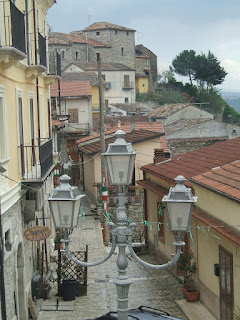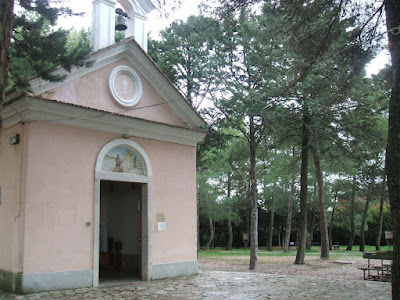I thought it would be nice if we took a little side trip today. I prefer to spend all my time in Torre, but the hubby always insists we explore other areas when we're in Italy. It's really not such a bad idea, as it allows me to check out some of the comuni around Torre, yet still keeps hubby happy.
Google maps tells me that Pietrelcina is 20 kilometers and approximately an hour and thirteen minutes by car from Torre le Nocelle. I love Google maps, but I don't think they're taking into account the actual speed at which most Italian drivers whiz down the Autostrada. Last year we made the trip in thirty minutes ... mostly as hubby hates for anyone to pass him on the highway... but also as he knocked back two espressos in the cafe before we even started. I've learned to limit his intake to one per trip, otherwise he thinks he's Mario Andretti.
Pietrelcina is best known as being the birth comune of Francesco Forgione, better known as Saint Padre Pio. I was very excited about finding the Forgione surname in Torre, as Padre Pio is one of my favorite saints, but alas .... I could not find a familial connection. No matter ... Pietrelcina is still a beautiful place to visit. The photos below were taken between the years 2004 and 2009.
There is parking just off a little side street behind the main piazza, so this is where we usually head first.
The piazza's not always this quiet. I like to take pics during the afternoon meal break when everyone else is home eating and napping.
The steps on the left lead up to Chiesa Santa Maria degli Angeli - the little church where Padre Pio celebrated his first Mass as a Capuchin priest.
Santa Maria degli Angeli. The little pizzeria to the left should not be missed either.
My Padre Pio!
Inside the church.
The Main Altar
Padre Pio's Confessional
Down the little side street that shoots off left from the piazza, you'll find the birth and maternal homes of Padre Pio, as well as dozens of little gift shops - most selling religious articles. There is also a superb little restaurant down this way, but I can't for the life of me remember what the name was. It has all of nine tables and the owner also does double-duty as chef and head (only!)waiter. Hubby and I had a three course meal complete with dessert, coffee and a bottle of wine for about 40 Euros.
The tiny birth home of Padre Pio
The two pictures on the right are of Maria Giuseppa de Nunzio and Orazio Forgione - parents of Padre Pio.
The Kitchen
The "Stove"
"This stone was used by the small Francesco (Padre Pio) as a pillow, during his childhood."
Wouldn't it be nice if ALL houses came with a genealogy of the inhabitants posted on the wall!
This ceiling just amazes me. I can't imagine the countless hours that must have gone into constructing this. Wouldn't the building inspectors in the States have a field day with that light? One little spark and poof! - there goes the interior of the house.
Aha! Do you see the little cane chair in the street? Directly across from that is the wonderful little restaurant previously mentioned.
These next few photos were taken in various spots in Pietrelcina
You'll find these window displays outside shops all over town.
A Di Iorio! (Unfortunately not from Torre.)
I just love the old, wrinkled face on this gentleman. When I asked if I could snap a pic of the donkey he threw his hands up in the air as if to say "Sure, go ahead. I don't know why you'd want a photo of us, but go ahead!"
These next few photos were taken in various spots in Pietrelcina
A Di Iorio! (Unfortunately not from Torre.)
I just love the old, wrinkled face on this gentleman. When I asked if I could snap a pic of the donkey he threw his hands up in the air as if to say "Sure, go ahead. I don't know why you'd want a photo of us, but go ahead!"
Massaria Forgione - Piana Romana
And last, but not least - Piana Romana. Located in the countryside of Pietrelcina is the farmhouse of the Forgione family. As a child Padre Pio would walk from their home in the "city" to the rented farm on the edge of town to tend the sheep.
In later years, due to his on-going health issues, Padre Pio was permitted to live near his family in Pietrelcina while still retaining the Capuchin habit. During this time he celebrated Mass, heard confessions, and often spent time praying in the countryside near the farm in Piana Romana.
It was there on 7 Sept 1910, while deep in prayer, that Jesus and Mary approached him and gave him the wounds of Christ, the Stigmata. He was so terrified by the phenomenon he begged the Lord to withdraw them. He did not wish the pain to be removed, only the visible wounds.
In 1916 Padre Pio was ordered to return to community life and was assigned to San Giovanni Rotondo, located in the Gargano Mountains of Italy in the province of Foggia. With the exception of a year spent in the Italian army, he would spend the remainder of his life there, at the Friary of La Madonna della Grazie.
Inside the farmhouse. All items shown are said to be original and were actually used by the Forgione family.
The little chapel of Saint Francis of Assisi. This was erected just around the corner from the farmhouse, on the site where Padre Pio received the stigmata.
Inside the chapel.
The tree Padre Pio was leaning against when Mary and Jesus approached him in 1910. Due to visitors taking home chunks of bark as souvenirs, it has since been relocated inside the chapel and placed behind protective glass.
Pietrelcina is a beautiful little town, and definitely deserving of a side trip should you find yourself in the vicinity - even if you're not a devotee of Saint Padre Pio. Great food, great scenery, and lots of history ... what more could you ask for?!



















































0 comments:
Post a Comment
Note: Only a member of this blog may post a comment.